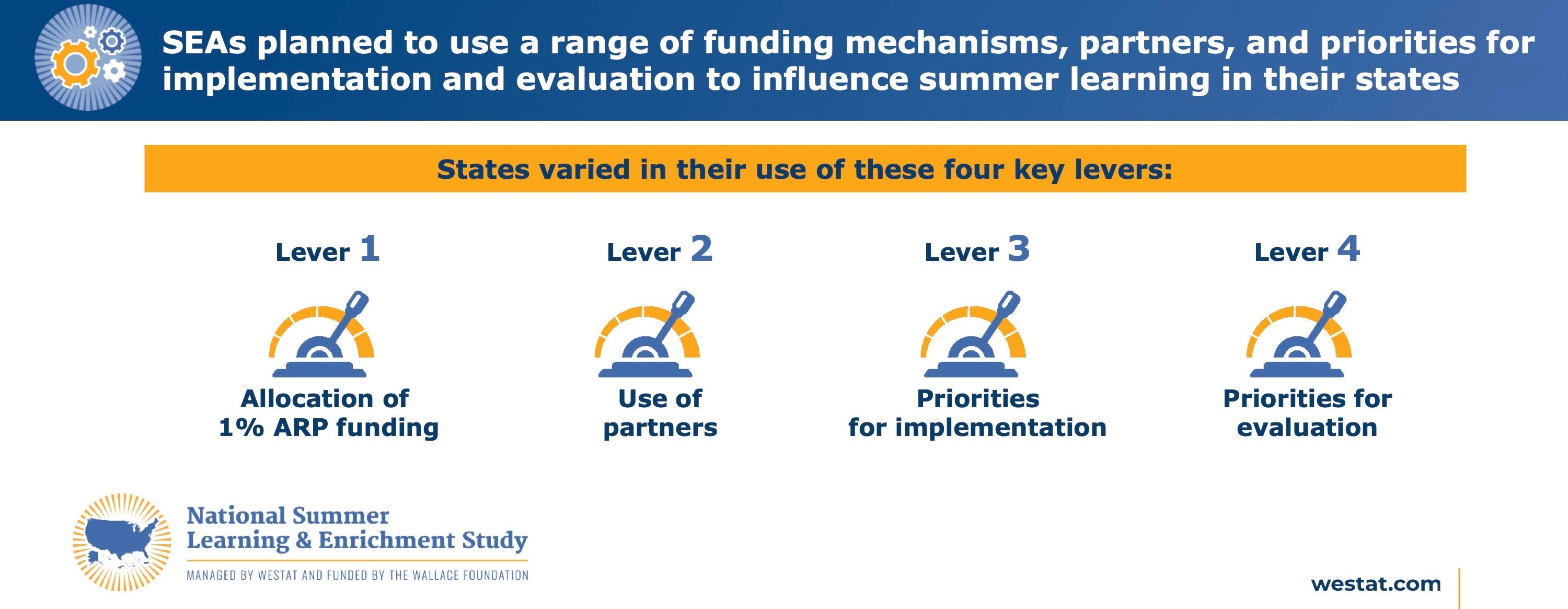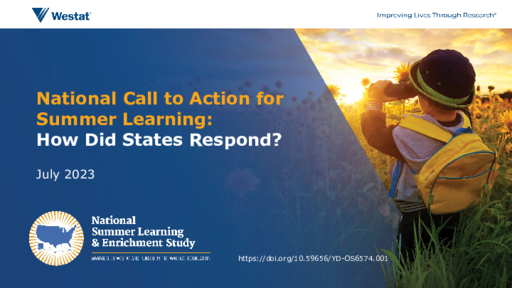Breadcrumb
- Wallace
- Reports
- A National Call To Action For Su...
A National Call to Action for Summer Learning
How Did States Respond?

- Author(s)
- Allison Crean Davis, John Hitchcock, Beth-Ann Tek, Holly Bozeman, Kristen Pugh, Clarissa McKithen, and Molly Hershey-Arista
- Publisher(s)
- Westat
Summary
How we did this
Westat analyzed the plans that the 50 state education agencies and the District of Columbia submitted to apply for American Rescue Plan funding. The researchers also interviewed education officials from 37 SEAs who were knowledgeable about summer programming. Results from the plan analysis and state interviews were then compared.
Major disruptions to school-year education during the COVID pandemic led to learning losses for many K-12 students. To counter the problem, the federal government sought to expand summer learning programming. State education agencies (SEAs) played a key role in making this happen. What did their work look like? And what are lessons for how states can foster high-quality summer learning beyond the pandemic?
This report from the Westat research organization helps answer these questions. It is the second in a series produced under Westat's National Summer Learning and Enrichment Study.
A Pandemic, a Learning Crisis, a New Focus on Summer Learning
In March 2021, the U.S. Department of Education called on state education agencies and school districts to try to mitigate learning loss by delivering high quality K-12 summer learning programs on a wide scale. Unprecedented federal funding, provided through the American Rescue Plan, supported this call.

Our vision is that we must provide opportunities…for all our communities, so that there is equity across the state.
— A state leader
How Did State Education Agencies Respond?
This report captures how SEAs responded to the learning crisis. It draws on an analysis of federal spending plans from the 50 states and Washington, D.C. It also draws on interviews with knowledgeable education officials from 37 states. Researchers found that:
- A majority of states envisioned and defined a new role for themselves in summer learning. Thirty of the 37 states reported developing a summer learning and enrichment vision. Some states shaped this vision by taking cues from how they had carried out other grant or afterschool programs. Many created entirely new support structures and policies. One state passed legislation mandating that program design and staffing requirements be included in district summer programming.
- SEAs used four key levers to influence summer learning.
- Lever 1: How and to whom states allocated funding. Nearly three-quarters of SEAs (71 percent) planned to distribute American Rescue Plan funding through competitive grant programs.
- Seventeen of the 37 states awarded funding to districts only. Twelve awarded funding to both districts and community-based organizations. Eight awarded funding to community-based organizations only.
- Lever 2: Whether and how states engaged partners. Some 62 percent of SEAs (23 of the 37) confirmed that they had engaged with partners to help plan for summer learning. Partners included local nonprofits, school districts, municipal agencies, and institutions of higher education.
- Lever 3: Which implementation priorities states established. Nearly four-fifths of states (78 percent) asked school districts to prioritize social and emotional elements in their work, for example.
- Lever 4: Which evaluation priorities states established. Nearly three-fourths of states (71 percent) prioritized data collection and reporting on participation and/or outcomes from school districts implementing summer learning.
- SEA actions sometimes deviated from written plans. In some cases this meant going above and beyond their original plans. For example, eight states took legislative action to shape summer learning beyond 2021. They passed new policies about how funding is awarded and programming is designed.
- States encountered challenges in their new summer learning roles. One was finding ways to change historical perceptions of summer learning. These perceptions included that summer learning is punitive or just for credit recovery. Another challenge was that state law sometimes limited a state’s authority to set priorities for use of federal funds.
The researchers plan to issue a final report.
Key Takeaways
- A majority of states envisioned and defined a new role for themselves in response to the summer learning call to action.
- SEAs used four key levers to influence summer learning.
- Lever 1: Funding Allocation.
- Lever 2: Use of Partners.
- Lever 3: Priorities for Implementation.
- Lever 4: Priorities for Evaluation. A majority of states prioritized data collection and reporting on participation and/or outcomes. More than half of states intend to expand data collection in future summers.
- SEA actions sometimes deviated from written plans. In some cases this meant going above and beyond original plans. For example, eight states took legislative action to shape summer learning beyond 2021. They passed new policies related to program design and funding.
- States encountered challenges in their new summer learning roles. One was finding ways to change historical perceptions of summer learning as punitive or just for credit recovery.
Visualizations

Materials & Downloads
What We Don't Know
The National Summer Learning and Enrichment study captures how states and school districts responded to the summer learning 2021 Call to Action. It does not capture the quality of programming delivered in summer 2021.



